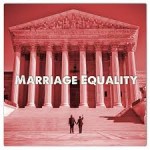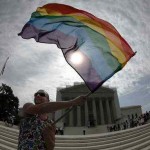- Home
- Figure out what you need
- 24Biz-Clovis
- Deluxe Trust Package
- Standard Trust Package Questionnaire
- Joint Trust Package
- Single Trust Package
- Deluxe Will Package
- Standard Will Package
- Single Will Package
- Children’s Document Package
- Advance Directives Package
- Update for Trust Package
- Update for Will Package
- Tell a friend and earn cash!
- Gift Certificate
- About our Packages
- Contact
- About Us
- Blog
What’s at Stake at the Supreme Court
 A
A
s it stands today, there are 37 states that allow gay and lesbian couples to marry. Many of those states had bans on marriage equality that were overturned by a judge or panel of judges. If the the Supreme Court does rule in favor of states having a right to ban marriage, those state’s bans may automatically be reinstated and the status of all those couples who relied on those rights while they existed (i.e.got married) would be in question.
Although the final decision will not be made until later in the summer, tomorrow, the Supremes will hear oral arguments in Obergefell v. Hodges to determine whether or not state bans on lesbian and gay marriage rights are constitutional.
There are nine Justices in total. Four of them -Ruth Bader Ginsburg, Stephen Breyer, Sonia Sotomayor and Elena Kagan – are liberal and will almost certainly vote to support marriage rights for all 50 states. Three others – Antonin Scalia, Clarence Thomas and Samuel Alito, are consistently conservative and have, in past cases, said they believe there is no constitutional right for marriage equality.
Then there is Chief Justice John Roberts – also conservative, but who has occasionally voted with the liberals in important cases. For instance, and much to the shock and dismay of the Tea Party, in 2012 he cast the deciding vote to uphold Obamacare. Although, Roberts DID side with conservatives when he voted against marriage rights in the Prop 8 and Windsor cases a few summers ago. However, he refused to sign onto the dissenting Justice’s opinion that declared that state bans on marriage rights were constitutional. So… it seems there is a chance he will decide to join the liberals in this case.
That leaves Justice Anthony Kennedy, who is almost consistently conservative – except on the issue of LGBT rights. Kennedy wrote the eloquent opinion in Lawrence v. Texas (that overturned sodomy laws) that – in my opinion – formed the basis for what has evolved for marriage equality ever since. If you want to read that opinion, here is the link.
Most Supreme Court experts believe Justice Kennedy will vote with the liberals in this case. Even if Chief Justice Robert’s sides with the conservatives, it will be a 5/4 ruling in favor of gay and lesbian couples having the right to marry.
Definitely not a sure bet – but a good one nonetheless.
We’ll be live-blogging on our Facebook Page tomorrow starting at 11:00. Hope to see you there!
A Guide to Tuesday’s Supreme Court Hearing on Marriage Equality
 The Supreme Court will hear oral arguments in the challenges to state bans on marriage equality on Tuesday, April 28, 2015.
The Supreme Court will hear oral arguments in the challenges to state bans on marriage equality on Tuesday, April 28, 2015.
Remember, the Justices will not be rendering a decision about marriage rights on Tuesday. They’re just listening to oral arguments presented by gay and lesbian couples (the petitioners) and states that want to deny their marriage rights (the respondents).
The Justices will have an opportunity to question the attorney’s who are representing the petitioners and the respondents. Then they’ll will make their final ruling later this summer.
I’ve written this handy guide to help you understand what is at issue and what to expect to happen that day.
There are actually four separate cases before the Court from four separate states: Ohio, Tennessee, Michigan, and Kentucky.
Back when they decided to hear these cases, the Court limited the issues to two questions:
1. whether the Constitution requires states to allow same-sex couples to marry; and
2. whether the Constitution requires states to recognize the marriages of same-sex couples who were legally married in another state.
These issues are now commonly known as the “marriage” and “recognition” questions.
Each petitioner and respondent is required to file a brief explaining the legal basis for their argument. In addition, there are also over a hundred amicus, or “friend of the court,” briefs filed by individuals and groups who support the petitioners and the respondents. The federal government even filed an amicus brief supporting the petitioners. Is your head spinning yet?
On the day of the hearing the Court may have a few other business matters to attend to before they get to the marriage equality question. For one thing, they may decide to take some time to release their decisions in previously argued cases. They might also hold swearing in ceremonies for new members of the Supreme Court bar. We won’t know for sure if any of this will happen until a day or two before the hearing, but, even if they do, it shouldn’t take too long.
After the other business is attended to, the Court will move on to the main event – the oral arguments regarding marriage equality.
The argument is being heard in two parts, each part based on the questions the Court wanted answered:
Part 1: The Marriage Question:
During the first half of the hearing, the Court will consider the “marriage” question. One attorney – Mary Bonauto, a longtime LGBTQ rights advocate – will represent all of the petitioners and she will get to make her argument first. Bonauto will get 30 of the 45 minutes given to the petitioners but will probably only speak for 25 of those minutes so she can preserve some time for a rebuttal (counter argument) after the respondent’s attorney makes his case. Bonauto will get an assist from Solicitor General Don Verrilli (the federal government’s top lawyer at the Supreme Court) who will speak for an additional 15 minutes on behalf of the petitioners.
Representing the 4 states (aka the respondents) will be John Bursch, the former solicitor general of Michigan. He also has 45 minutes to argue the state’s side, but he is not entitled to rebut after the petitioner’s counter argument.
After Bursch is finished presenting the respondent’s side of the case, Mary Bonauto will have a chance to respond to and rebut the arguments put forth by Bursch.
Part 2. The Recognition Question:
In the second half, the Court will spend 1 hour of oral arguments on the “recognition” question. The petitioners will be represented by attorney Douglas Hallward-Driemeier and the respondents will be represented by Joseph Whalen. Each attorney will have 30 minutes to argue the recognition question although the petitioner’s attorney may want to save a few minutes of his time to counter the arguments put forth by the respondent’s attorney.
When the petitioner’s attorney is finished with his rebuttal the Chief Justice will officially end the hearing.
Although the oral arguments will be over, the show will continue outside on the Court’s plaza, where LGBTQ advocates will face off with the shrinking anti-marriage faction. I’s a huge case with national implications so there will no doubt be a media circus as well.
All in all it should be an awesome spectacle!
Be sure to visit Rainbow Law’s Facebook Page on Tuesday where we will live-blog the oral arguments as they happen. And make sure you sign up for our newsletter so you can receive up-to-date information about your legal rights.
We’ve come a long way but still have a long way to go to full legal equality!

Here are the links to the briefs:
Petitioner and Respondent Briefs
Amicus Briefs
A Time to Ride
All of this support for marriage equality has my head spinning. In 2004, we rode our bicycles 3800 miles from San Francisco to NYC to advocate for marriage equality – through California, Nevada, Utah, Colorado, Wyoming, Kansas, Missouri, Illinois, Indiana (yes, THAT Indiana), Ohio, Pennsylvania and New York. I met supporters and lots of haters – including the infamous Phelps family who protested our event in Topeka. Throughout the entire ride, then president George W. Bush was calling on Congress to amend the US Constitution to forever ban marriage equality. That was then. This is now. What a difference 11 years makes! Here is the trailer of the documentary made of our ride:







